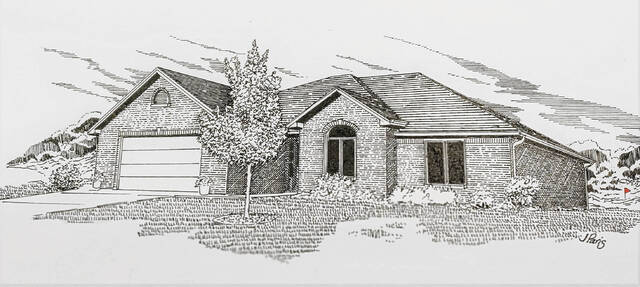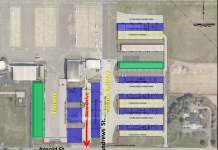For as long as Jim Paris can remember, he was most comfortable with a pencil in his hand.
“As a kid, I would lay in the yard, drawing what I saw,” said Paris, now 82 and retired after a four-decade career as a Columbus architect.
By the time Paris was a sophomore at Columbus High School in 1955, others were seeing the potential in his abilities — especially drafting instructor Mel Harrison.
The vocational education teacher placed Paris in a co-op program as an upperclassman, allowing him to spend mornings in class and afternoons in the office of home designer Don Hodler, where the young man learned design techniques.
Paris figured the experience might help him earn a position as a draftsman with Cummins Engine Co. or Arvin Industries, the city’s leading manufacturers. Such a job wouldn’t require a college degree, an education level Paris never considered pursuing while in high school.
But Paris also showed an ability to execute plays drawn up by Indiana Football Hall of Fame football coach Max Andress. The Columbus fullback was named most valuable player his senior year, when he made the all-South Central Conference team.
That drew the attention of Dartmouth College in Hanover, New Hampshire, which offered Paris a football scholarship. But the private Ivy League college didn’t have an architecture program, the career path Paris became convinced he should pursue.
Drafting instructor Harrison urged Paris to apply to the University of Cincinnati for admission to its architecture program. “So I did,” Paris said. “And I was rejected.”
Since Paris hadn’t planned on pursuing a professional degree, his lack of college-prep classes became a red flag in his Cincinnati application.
But high school counselor George Utterback “went to bat for me,” Paris said, and contacted the university.
“They accepted me on the basis that I would take a night course to make up for that (academic) deficiency,” he said.
Having to attend night school resulted in a heavy course load his first year at Cincinnati, but the extra work paid off after 1963, when Paris completed the six-year architectural program and entered the work world.
By 1970, his hometown’s design reputation was well underway. That’s when Paris would launch his own architectural firm in Columbus, a move that would eventually cement his personal reputation in the field. Through his 2004 retirement, Paris and his business partners — especially Nolan Bingham — would complete 400 buildings in central Indiana, most of them in Columbus.
Three projects would stand tallest:
Paris’ 1976 restoration of the Columbus Pump House, built in 1903 following a Harrison Albright design, as the 15,156-square-foot home for Senior Center Services of Bartholomew County at 148 Lindsey St., a $441,000 project.
Paris’ 11,700 square-foot addition to the 87,000-square-foot Cleo Rogers Memorial Public Library at 536 Fifth St., using a two-story atrium in 1987 to connect the addition with the 1969 structure designed by E.M. Pei, a $2 million project.
Expansion of Columbus Fire Station No. 1, by Paris and Bingham, adding 10,648 square feet onto the 4,600-square-foot Art Nouveau and Art Deco station design by Leighton Bowers from 1941 at 1117 Washington St., a $2.2 million project completed in 1990.
Columbus Pump House
The old utility building housed pumps that drew water from the adjacent East Fork of White River before it was sold to Southern Machine Company, a tool-and-die maker that operated from there until 1971. Afterward, it was purchased by the Columbus Redevelopment Commission as part of a downtown renewal project — and Paris was hired to rescue it.
“The old roof was replaced without altering the original style. The red brick, some of it covered with decades of coal and dust, was cleaned and repaired inside and out. Broken windows were replaced and new heating and air conditioning systems were installed. The interior was gutted except for large brick support arches that form a frame for stairways and for balconies looking down onto the ground level,” cultural historian Barbaralee Diamonstein wrote in her 1978 book, “Buildings Reborn: New Uses, Old Places.”
“It was a mess – grease, dirt everywhere,” Paris said. “Structurally, it was fine — very solidly built.”
Paris’ design connected different levels of the building with a walking ramp. He opened up the main floor, increasing functionality by cutting two additional arches through 18-inch walls between what’s now the dining area and bar of the current owner, Upland Columbus Pump House brewery and restaurant which opened in 2016.
The Pump House project was among more than 100 examples nationwide of recycled buildings featured in the book. It was also part of a touring “Buildings Reborn” photo exhibit.
The restoration enhanced Columbus’ growing architectural reputation while providing a functional space for Bartholomew County senior citizens to utilize between 1976 and 2011, when the new Mill Race Center opened down the street.
Cleo Rogers Memorial Library
Within about 15 years after its $2.5 million library opened, the Bartholomew County Library Board determined it needed more space to meet community needs. It hired Paris to design an addition to the north side of the building — enclosing a brick courtyard to house the library’s Indiana Room, fiction collection and reference section, then in the basement.
The board sent Paris to New York City to discuss the project with Pei, who designed the local landmark and was considered one of the world’s finest architects. The two met for several hours inside Pei’s private office.
“He was very curious, wanting to know what I was going to do to his building,” Paris recalled.
Pei suggested that if the library board needed more space, it should construct a separate building with a design distinctly separate yet complementary to his original structure, Paris said.
That’s when Paris shared sketches showing ways to connect two adjacent buildings. He and Pei settling on the concept of a two-story glass skylight atrium.
The addition seamlessly blends with the 1969 building, using the same window design and a brick so close to the original that it’s difficult to tell the difference, Paris said.
Building over the open courtyard, which leaked water into the library basement, also solved a problem from the original construction, he said.
Paris described the library’s relationship with and proximity to its more established neighbors, the 1864 Joseph I. Irwin Italianate mansion and the 1942 First Christian Church, the city’s first Modern building, designed by Eliel Saarinen.
“They enhance one another, the old and the new,” Paris said, with the library and plaza “the anchor that makes the whole thing work.”
With more than 70 architecturally significant Modern buildings in Columbus, Paris doesn’t hesitate when identifying the library as his favorite.
“I still think it’s the premiere building in Columbus,” he said.
Fire Station No. 1
When city officials determined that the nearly 50-year-old Central Fire Station no longer met its needs, they hired Paris and Bingham in the late 1980s to design an addition that would quadruple usable space. The addition provided taller truck bays to accommodate bigger vehicles, comfortable sleeping quarters and updated kitchen and dining areas, plus modern amenities such as a weight room and recreation areas. It also created enough space to enable fire department administrative offices to return after being housed in Columbus City Hall for three years.
It did so without touching the cherished 1941 structure, a condition stipulated by Barbara Stewart, wife of then-Columbus Mayor Robert Stewart, Paris said.
The building had inadequate heating, electrical systems and insulation, a leaky roof and a shortage of space and facilities for firefighters. But it also featured distinctive rounded building edges made of buff brick, limestone, glass and stainless steel.
Renovations require imagining how a building can be revitalized for a new purpose without dramatically changing the look and style of the original architecture, Paris said. So he and Bingham designed a modern addition that featured a rounded exterior wall at its entrance.
“Jim’s gift was to read another architect’s style and continue that conversation in a way that fits current times,” said Richard McCoy, executive director for the Landmark Columbus Foundation, created in 2015 to care for, celebrate and advance the city’s architecture, art and design — including saving architecturally significant structures.
“I don’t know that there was a more significant player in Columbus from the 1980s through the 2000s that cared for and advanced the architectural legacy of Columbus,” McCoy said of Paris.
“The fire station is an outstanding example of an expansion. And the Pump House is just as impressive. It allowed a building that is now over 100 years old to continue as a community asset,” McCoy said.
In light of Paris’ expertise with renovations, including the 2001 expansion and renovation of Home Federal Bank (later Old National Bank and Centra Credit Union) at 501 Washington St., most of his designs were for new construction.
His firm designed more than 20 banks, which became a major part of its business, as well as medical offices across Columbus.
In the mid-1970s, Paris designed a complex of medical offices on the north side of U.S. 31 at Washington Street, known as the National Road Professional Plaza. The buildings feature shed-type roofs and clerestory windows just below the roofline, among his signature design styles.
Paris also used shed-style roofs for a 1983 medical building at 1655 Gladstone Ave., now occupied by Southern Indiana ENT and Neurology and Sleep Sciences.
Paris said he was influenced by the Modern design styles — including shed roofs — of architect Frank Lloyd Wright, who designed more than 1,000 structures through the 1950s.
Paris and Bingham, who died in May at age 74, are among 39 architects or architectural firms listed by the Columbus Area Visitors Bureau to have worked on projects of distinction in Columbus the past eight decades, yet the pair don’t garner equal notoriety as more celebrated designers.
“I don’t think Jim’s impact is as well understood as it could be, and that’s something that over time will become more apparent,” McCoy said. “Working in Columbus is something that I’m sure drew out the best in everything he worked on. Columbus demands everyone’s best.”





